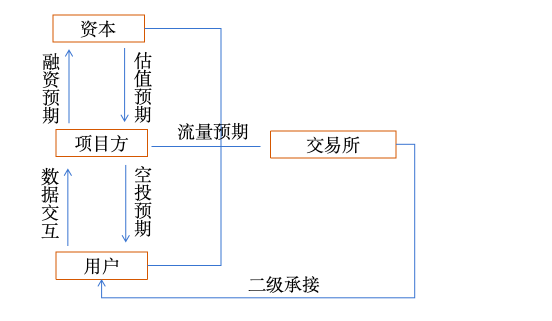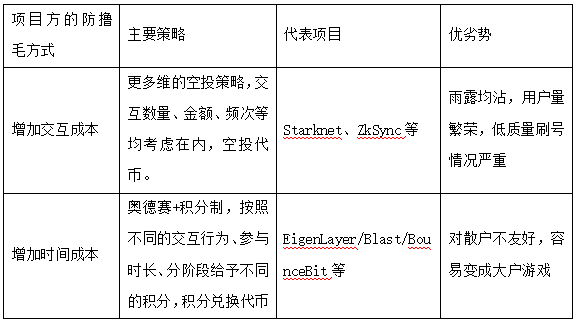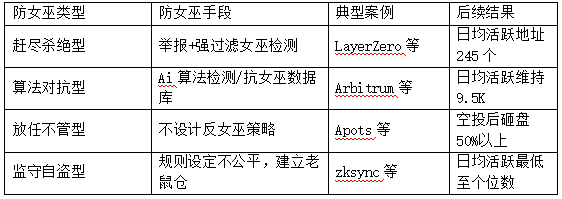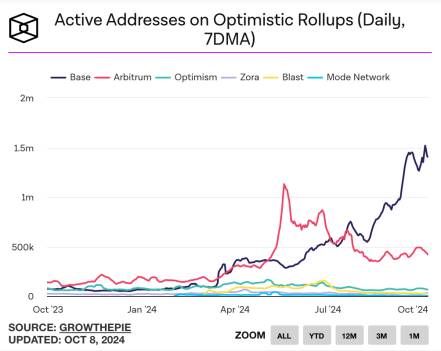How to manage airdrop expectations: The correct way for project owners to develop a "big picture"
Written by: IceFrog
Foreword:
Jesse Livermore, a stock trader, once said, "Money comes by sitting and waiting." Regardless of the profound meaning of this sentence in trading, at least inBlockchainThis statement is undoubtedly true for the airdrop track. However, four years after Uniswap launched a large-scale airdrop, the airdrop track has changed dramatically. Money is still earned by sitting and waiting, but you don’t know whether it will be pork trotter rice or Michelin set meal, or maybe you are just waiting in vain.
No Mao Zedong party would be satisfied with the pig trotter rice style airdrop, but they would not become enemies. What is really hard to accept is "You said you are my sweetheart, but you did insider trading behind my back; you said you are tall, rich and handsome with a strong background, but you just wanted to trick me into going to Myanmar; your expectations were not met, and you said I was a bastard."
"You betrayed me and let me laugh it off", the lyrics reflect reality, and are particularly profound in the case of airdrop expectations, because paradoxically, every airdrop participant believes that this is a true reflection of their inner thoughts. The deep reason behind this is the expectation gap, and the source of the incident is the project party's airdrop expectation management.
If we want to change the situation where users “quit” due to this expectation gap and avoid the project becoming a ghost town, then managing airdrop expectations with the correct attitude of “big picture” is a compulsory course for all project parties in the next stage. Before that, we must clarify how airdrops evolve andCommunityHow do you view airdrops, and then manage them based on "giving up PUA fantasies and doing projects honestly"CommunityAirdrop is expected.BlockchainThe world has proven countless times that the community is the solid foundation for a project to have lasting vitality. Without community support, it may not die today, but it will definitely die tomorrow.
1. Evolution and Current Status of Airdrops
1. Origin and essence:
Contribute to create value or buy traffic. Think of it as an extension of your thinking. Your stance determines your direction.
Since Uniswap was launched in 2020BlockchainAfter the world's first large-scale airdrop was a huge success, airdrops have become one of the most effective strategies for launching projects in the crypto industry. Accompanied by huge wealth feasts, in less than four years, airdrops have become a highly specialized sub-industry.
At the same time, the Mao Mao Party and the project party went from love-hate relationship to the final confrontation. The project party repeatedly performed PUA users by continuously raising expectations in exchange for huge financing; the users, with the determination to "bear humiliation", staged the drama of running away and withdrawing the ladder immediately after the airdrop.
The deterioration of this game can be traced back to the source of the airdrop.
-
在早期 ICO 热潮的空投时代:区块链尚属于蛮荒之地,彼时的空投不需要交互,有地址便可以获得Tokenairdrop;
-
Later, when liquidity mining became popular, it was replaced by liquidity mining rewards. The growth of TVL was accompanied by the maturity of mining, withdrawal and selling.
-
The Uniswap airdrop kicked off the era of airdrops and provided an excellent example for the promotion and launch of subsequent projects. Since then, airdrops have officially become a means for many projects to attract new members, raise funds, and go public.exchangeAs a result, airdrop-focused groups have emerged.
Under the same rules, different participants have completely different perspectives on the same thing, which is the beginning of chaos. The same is true for blockchain airdrops.
-
From the perspective of the project party, in terms of the business model, on the one hand, it is the idea of buying traffic for promotion. There is no need to worry about making money by using traffic, whether it is liquidity mining or project financing; on the other hand, it is to achieve decentralization from the governance structure to complete the complete construction of the project.
-
From the user's perspective, it is about contribution and creating value. Since I have made a contribution, it is only natural that you should give me something in return.
-
From a certain perspective, the two have the same interests, but the major difference is that the recognition of contributions and the power to judge value are not in the hands of users. Once abused, conflicts are inevitable; more importantly, the project party does not have strong enforcement constraints on the responsibilities corresponding to power.
-
This further leads to the situation that users must constantly cater to the value judgment standards of the project party through clues of the project. The project party has the power to change its judgment standards at any time according to the needs of different stages. With the rapid growth of the blockchain market value, especially with the addition of huge amounts of capital, capital is mixed with complex interest distribution. The project party needs to steer the direction and balance the interests among the positions of various groups.
Things always move in the direction of least resistance.
-
For a project, capital is the financial sponsor.exchangeHe is the father behind the sponsor.
-
At first, users were gods, then they became partners, and later they were just numbers.
For project parties with unlimited power, it is naturally a fairly easy decision to make as to who to sacrifice when necessary, especially after the rise of LuMao Studio.
-
Some project parties obtained large amounts of financing based on the massive data brought by LuMao Studio.
-
While stepping up efforts to buildWitchDetection methods are ready to deliver precise strikes the moment the feast begins.
-
There are quite a few projects that are both established and under-established. The fundamental reason behind this is that the project owners have absolute control over the power of airdrops.

From the above figure, we can see that in the ecosystem of users, projects, capital, and exchanges, from airdrop expectations to project financing expectations, capital valuation expectations, and exchange traffic expectations, all expectations depend on user data interactions.
In practice, in order to meet regulatory requirements, it is theoretically necessary to increase the TokenAll will be distributed to the community, and most of them will use no more than 10% for airdrops. If we consider the proportion of the project party itself and the proportion left for the capital party, it is quite limited. Therefore, it is not difficult to understand the phenomena of raising valuations through data, insider trading, and shipments during the lock-up period.
In the face of interests, uncontrolled power is a sickle wielded towards users.
2. Development and evolution:
从代币到积分,流量价值与利益纷争,PUA 与反 PUA
With the users' catering, the project parties' acquiescence and the capital's promotion, the wool pulling industry has become an important part of the project construction.
The wealth effect brought about by high valuations satisfies the demands of capital, but it also lays the foundation for the rise of the LuMao Studio. With a huge number of robots brushing accounts, the project parties have mixed feelings of love and hate. If the wealth is big enough, then only hatred will remain.
How to avoid account fraud to the greatest extent possible while increasing the number of users? The freeloaders are evolving, and the project owners are also evolving.
The most direct and effective way is to increase the cost of making money, but in order to retain the money-makers, the expected returns have to be magnified. This creates an expectation gap and indirectly leads to the birth of highly valued VC coins. After all, projects that are capable of implementing a points system all have luxurious investment backgrounds.

From the results, there is no doubt that the points system effectively avoids low-quality account-brushing behavior by increasing time costs and various stage-by-stage levels, but this also leads to the loss of retail investors and becomes a game for big investors and studios, which further leads to the situation that once a project is launched, the freeloaders and the project parties will not take over each other.
在项目 TGE 上线,甚至开启空投前,不同的项目方也祭出了不同的防女巫手段,导致的结果也不尽相同。

It is obvious from the above table that in an industry, if the water is too clear, there will be no fish. If you confuse the result with the purpose, you will usually not get any good results. The point system and anti-witch are means to filter out fake users, not the ultimate goal.
-
It is not advisable to exterminate all witches through the extreme test of humanity;
-
It is even more undesirable to leave it alone completely;
-
But through the rat warehousesteal, then it is a heinous crime.
-
Even if the point system is used to avoid some low-quality account-brushing, the allocation of points and the transparency of the rules, including the endless stream of behaviors that encourage quantity first and then discourage users, it is not surprising that user trust is overdrawn and project data plummets.
The project party's PUA methods are sophisticated, but as long as it is profitable, the anti-PUA of the Mao Mao party will be more fierce, from low-income accounts to high-quality accounts, from script automation to studio team operations, to large-scale human wave tactics, and even launching script attacks on Github.
Although some people have said that airdrops are dead as early as 2023, there are still a large number of professional airdroppers to this day. The fundamental reason is that due to the rapid growth of the crypto world, airdropping is still a very profitable business.
From the perspective of the project party, they are even more dependent on the Mao Zedong party. When the bear market comes, the Mao Zedong party is the only liquidity they can rely on. After all, as the old saying goes, there is no winter that the Mao Zedong party cannot overcome.
3. Embarrassment and dilemma:
From traffic to retention, everyone wants to change their fate, but no one can keep their original intention.
For project developers, in the rapidly changing blockchain world, user attention is very limited, and competing for user attention has become a compulsory course for every project developer.
The most effective thing is undoubtedly the wealth effect brought by airdrops, and the subsequent "retention" has become a major pain point for project parties. The ghost town of blockchain is both the cause and result of traffic.
-
After most projects airdropped coins, the participants refused to take over from each other, causing the coin price to plummet. Anti-VC coins once became a consensus in the market. The most critical reason for this was the overall sluggish market and cyclical rotation.
-
When the valuation is high in the bull market and the coins are issued in the bear market, naturally no one will take over.
-
Even if the bull market picks up, external liquidity will focus more on mainstream currencies such as Bitcoin and Ethereum, and newly listed VC coins can only be a battle for existing funds.
The loss of the wealth-creating effect is the biggest original sin of the crypto world. Everyone who comes to surf the crypto world undoubtedly has the desire to change their destiny.
With the intervention of mainstream capital, the increasingly prosperous capital operation and the insufficient growth of loyal crypto users have formed the most core contradiction:
-
With the support of huge capital, the project owners regard the scoundrels as electronic beggars, but they have to rely on the support of the scoundrels.
-
The profiteers study the project rules tirelessly, creating a false prosperity for the project in a professional and industrial way, but they also dislike the project party's harsh witch rules.
The core of the contradiction seems to be the PUA-like points system or the witch system, or the robot account brushing; but fundamentally it is still because users' expectations of the value of the airdrop and the uncertainty of the points expectations continue to increase, and the project side is dissatisfied with the situation of a sharp drop in traffic after the airdrop was released. This is a confusing account, but it is not completely impossible to clarify.
Power is accountable only to the source of its power.
As mentioned above, the project owners have absolute power over airdrop distribution and rules. However, in a game where power is unconstrained, the cost of doing evil is too low. What some project owners don’t understand is that their current power is accumulated by countless users. Users have the least power in this ecological niche, but they are precisely the source of power.
Therefore, it is necessary to understand how users view the airdrop expectations and why some projects can still do it and still have a large number of supporters after the airdrop.
2. How does the community view the airdrop expectations?
1. Profits, but also fairness and transparency
For community users, the primary purpose of airdrops is to get expected or exceeded benefits. Studios use scripts to batch brush accounts or human sea tactics to implement points plans. Project parties use technology to counter technology and try to improve loopholes in the rules as much as possible to avoid large-scale witch data. There is nothing wrong with this, such as Arbitrum.
Although the rules and anti-sybil technology cannot be perfect, under relatively fair rules, most people will be satisfied, which will also provide a strong foundation for the project's reputation and subsequent activity.
If the rules themselves are unfair, whether it is a points system or token airdrops, they will be condemned and opposed by users, for example:
-
There was the Zksync insider trading controversy before.
-
Or maybe Starknet's rules favor developers.
-
Even Taiko's refusal to publish the rules.
-
As well as the non-disclosure of points in IO projects, PUA user behavior, and so on.
The root cause of the public outrage and community condemnation is the unfairness and opaque system, which led to large-scale user loss.

2. Short-term traffic co-construction is necessary, but long-term value links are also important.
If the project itself is good enough and combined with a thriving ecosystem and excellent experience, the money-grabbing party and the project party will become a story of mutual benefit.
For example, even if Base does not issue Tokens, it can still benefit from the high-quality ecosystem project friend.tech.make moneyeffect, attracting a large number of users; Arbitrum and Op form a broader positive flywheel through continuous token incentives for ecological projects.

As long as the project has long-term value, has its own continuous blood-making ability and strong operational capabilities, rather than simply relying on short-term airdrop expectations to reap profits, then even if there are occasional witches that slip through the net, it will still stand in the market for a long time. Both the wool-pulling party and the real users will eventually be strong supporters of the ecosystem.
3. How can project parties manage airdrop expectations?
1. The formation of expectation bias: asymmetric expectations and unforeseen information
Any deviation in expectations comes from asymmetric expectations and asymmetric information, which can be seen in many cases of failed airdrop operations.
The psychological changes of failed projects are generally divided into four stages:
-
Phase 1: hint at the airdrop expectation and attract customers to roll up GAS and deposits.
-
The second stage: The data is good enough, financing is obtained, the valuation is stable, and it is ready to be listed on the exchange. At this time, the many accounts of the money-grabbing party are a bit annoying, and they want to find a way to get rid of them.
-
The third stage: When you find that community expectations are already very high, any big move at this time can easily trigger a community backlash, so you will roll it all in and build a short position.
-
Stage 4: I know you want to crash the market, so I will do the same. There is no such thing as a lock-up period.
In fact, the above psychological changes are common in the airdrop cases of anti-users. The most fundamental problem is:
-
When you are needed, you are the user and God;
-
When you are not needed, you are an electronic beggar and a cancer.

The root cause of raising expectations and abandoning the donkey after it has done its job is that the project party has no constraints at all. When you use ambiguous information to continuously raise users' expectations, you cannot say that this is the user's greed; as mentioned in the preface, you say you are tall, rich and handsome, but you always want to trick people into going to Myanmar.
Information opacity and differences in expectations together constitute the cognitive inconsistency between project owners and the freeloaders, which is also the most direct reason for expectation deviation.
2. The core secret of expectation management: Don’t overstate, don’t go back on your word, and be able to deliver
In actual project operations, many project parties deliberately describe the value of airdrops/points vaguely, leaving room for interpretation to users, in order to continuously motivate users. This is actually a good method.
But it should be noted that ambiguity does not mean having no bottom line, nor does it mean being capricious.
The Fed is undoubtedly the best and most time-tested institution in the world for expectation management. Expectation management has three important cores: don’t overstate, don’t go back on your word, and be able to deliver.
-
Not saying enough: Corresponding to the project, users can be allowed a certain amount of room for interpretation in the subsequent guidance, but the basic bottom line of the rules must be clear and unshakable; the guidance of users must be corrective and continuous, rather than allowing the community to ferment until it is out of control, such as Starknet.
-
No repetition: Many project owners are inconsistent in formulating rules, openly diluting the value of user airdrops. This is basically a behavior without a bottom line, which is a huge harm to users, such as the recent Scroll. Others make some unnecessary actions, such as Blast, which started advertising at the critical moment of claiming airdrops without informing users. The founder's short video must be watched, and the embarrassment is almost as bad as the opening animation of Gree mobile phones. The current market value is almost plummeting.
-
Ability to cash out: This is an important reflection of the project party’s pattern. There are countless small-scale project parties, and the specific manifestation is no airdrop or airdrop low-value tokens or NFTs.
In fact, we infer from the results that the larger the project, the higher the market value. Especially when users say that this is a small project, it is almost like a declaration: Don’t take over in the secondary market.
3. Some suggestions: balance interests, community first, project-based
As mentioned at the beginning of the article, there are different expectations among project parties, users, capital, and exchanges. The essence behind the expectations is the pursuit of interests. While doing a good job of expectation management, it also means doing a good job of balancing interests.
The current situation is that the probability of a highly valued token project breaking the issue price immediately after launch is almost 99%Xiaobai Navigation, a few individuals haveBinanceIn order to break the current vicious cycle and airdrop dilemma of VC coins, and put aside the market's bull-bear conversion itself, the project side must clearly realize that in addition to the money of the Mao Mao Party itself,cryptocurrencyThe market itself has entered a stage of elimination competition where the fittest survive. In the case of insufficient liquidity, extensive management methods will not only fail to gain community recognition, but may also backfire.
For a project, in the current environment, airdrops are undoubtedly still an effective way to attract new users and promote projects, but designing an airdrop plan on a fair and transparent basis is a prerequisite, otherwise it is better not to issue tokens; secondly, in terms of understanding airdrops, we must clearly realize that the cost of airdrops is a marketing and promotion fee, as well as the cost of buying traffic, and it is a one-time incentive behavior, and it cannot be taken for granted that this is an investment in users; as long as it is marketing and promotion, there will naturally be the issue of conversion rate, and how to convert it in the future requires the project party to continue to build and further convert it into sustainable revenue.
Attaching importance to community building, project owners should recognize the value of a good community operation, and the success of the MEME track has set an example. Projects must build a broader user base through communities, KOLs, etc. to achieve truly effective growth.
-
Use technology to fight against robot account manipulation, rather than pollute yourself;
-
Communicate with the community with a more sincere attitude rather than PUA;
-
Win users' respect through fairness and transparency, rather than gain their disdain through deception and pettiness.
IV. Conclusion
There are not many big hairs left for the hair-pulling party, which is inevitable for the industry to move towards mainstream development;
Similarly, there is not much time left for project parties to engage in PUA, which is also an inevitable result of the change in industry narrative.
The article comes from the Internet:How to manage airdrop expectations: The correct way for project owners to develop a "big picture"
The rapid development of the re-staking industry has brought new growth points to the Ethereum ecosystem and the entire blockchain market. 1. Background of staking and liquidity staking Ethereum staking is to protect the network by investing ETHSafety, and in return receive additional ETH rewards. This mechanism was originally designed to strengthen the Ethereum networkSafetyHowever, there are some risks and limitations. First, the quality…